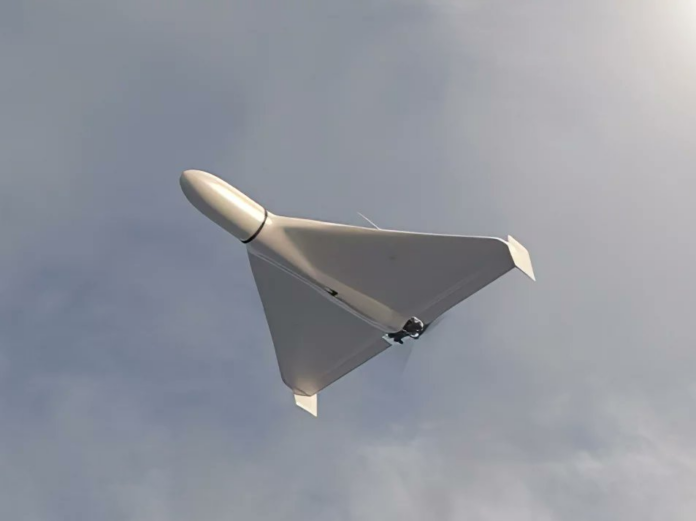Shahed-136: Russia’s Kamikaze Drone
The Shahed-136, an Iranian-made kamikaze drone, has become one of the most recognizable and effective tools in Russia’s drone arsenal during the Ukraine conflict. Originally developed by Iran, the Shahed-136 has been rebranded by Russia as the Geran-2 and is primarily used for long-range strikes against Ukrainian infrastructure, military targets, and supply lines. Its low radar signature, pre-programmed flight paths, and explosive payload make it a formidable weapon in Russia’s efforts to overwhelm Ukrainian air defenses.
Shahed-136: Design and Specifications
The Shahed-136 is a loitering munition, often referred to as a kamikaze drone, designed to carry out one-way missions where it crashes into its target and detonates an onboard explosive warhead. Its delta-wing design and rear-mounted pusher propeller allow it to achieve a low radar signature, making it difficult for air defense systems to detect and intercept. The Shahed-136 is guided by GPS, allowing it to follow pre-programmed flight paths to its target.
- Specifications:
- Length: 3.5 meters
- Wingspan: 2.5 meters
- Weight: 200 kg
- Speed: 185 km/h
- Range: 1,000 to 2,500 km
- Warhead: 30-50 kg high-explosive fragmentation warhead
- Guidance System: Inertial navigation with GPS
The Shahed-136’s warhead is capable of causing significant damage to fortifications, vehicles, and infrastructure. Its long-range capability allows it to be launched from deep within Russian-controlled territory, giving Russia the ability to strike Ukrainian targets far behind the front lines.
Operational Use in Ukraine
The Shahed-136 has been used extensively by Russia in its campaign against Ukrainian military infrastructure and critical civilian infrastructure, including power plants, bridges, and fuel depots. Its ability to travel long distances and evade radar detection has made it a preferred weapon for targeting sensitive Ukrainian assets.
Strikes on Ukrainian Infrastructure
One of the Shahed-136’s primary roles has been to target Ukrainian power plants and energy infrastructure. By launching swarms of drones, Russia has sought to overwhelm Ukraine’s air defense systems and disable its ability to generate power. These strikes have caused significant disruptions to civilian life in Ukraine, especially during the winter months, when power outages have become a common occurrence due to Shahed-136 strikes.
Attacks on Ukrainian Military Targets
In addition to civilian infrastructure, the Shahed-136 has been used to target Ukrainian military installations, including ammunition depots, command posts, and radar systems. The drone’s ability to carry a high-explosive warhead has made it particularly effective in destroying fortified positions and artillery batteries. By using the Shahed-136 to destroy Ukrainian radar systems, Russia has also been able to weaken Ukraine’s air defense network, creating openings for Russian aircraft and missiles to operate with less risk of interception.
Psychological Impact on Ukraine
The Shahed-136 has also had a profound psychological effect on the Ukrainian population. The drone’s characteristic loud buzzing sound has earned it the nickname “flying lawnmower” among Ukrainian civilians and soldiers alike. Its presence in the skies has created a sense of constant anxiety, as both military personnel and civilians are aware that they could be targeted by a kamikaze drone at any moment.
Advantages of the Shahed-136
The Shahed-136 offers several advantages that make it a highly effective weapon for Russia’s military operations. Its long range, low cost, and stealthy design allow it to carry out precision strikes on high-value targets with minimal risk of interception.
Low Radar Signature and Stealth
One of the Shahed-136’s most important features is its ability to evade radar detection. The drone’s small size, slow speed, and low altitude flight path make it difficult for traditional air defense systems to detect and intercept. This has allowed Russia to use the Shahed-136 in saturation attacks, where multiple drones are launched simultaneously to overwhelm Ukrainian defenses.
Long-Range Strikes
With a range of up to 2,500 kilometers, the Shahed-136 can be launched from positions far behind the front lines, allowing Russia to target deep inside Ukrainian territory. This capability has proven especially useful in disrupting supply lines, destroying logistical hubs, and creating havoc behind enemy lines.
Cost-Effectiveness
Compared to other missile systems or manned aircraft, the Shahed-136 is relatively inexpensive, with an estimated cost of $20,000 to $60,000 per unit. This low cost allows Russia to deploy large numbers of drones in saturation attacks, increasing the likelihood of overwhelming Ukrainian defenses while minimizing the financial cost of each individual drone.
Challenges and Limitations
While the Shahed-136 has proven effective in many scenarios, it is not without its limitations. Ukrainian forces have developed several countermeasures to mitigate the impact of Shahed-136 attacks, including improved radar systems and air defense measures.
Vulnerability to Air Defenses
Although the Shahed-136’s low radar signature makes it difficult to detect, it is still vulnerable to modern air defense systems once it has been identified. Ukrainian air defense units have become increasingly adept at intercepting Shahed-136 drones, using systems like the S-300 and NASAMS to shoot down drones before they reach their targets. However, the sheer number of drones launched in some attacks has made it difficult for Ukrainian forces to intercept them all.
Limited Payload
The Shahed-136’s payload of 30-50 kg is effective against unarmored targets and infrastructure, but it is less useful against heavily armored vehicles or fortified military positions. In situations where Russia requires greater explosive power, other weapons systems, such as missiles or artillery, may be more effective.
Strategic Impact on the Battlefield
The Shahed-136 has had a significant impact on the Ukraine-Russia conflict, particularly in its ability to carry out long-range strikes against Ukrainian infrastructure and military assets. Its cost-effectiveness and stealth capabilities have allowed Russia to maintain a constant threat to Ukrainian forces and disrupt logistical networks deep inside Ukrainian territory.
Tactical Flexibility
The Shahed-136’s long range and stealth capabilities give Russia a high degree of tactical flexibility, allowing them to strike targets at will from remote locations. This has forced Ukraine to spread its air defenses thinly across a wide area, making it harder to defend key infrastructure and military assets.
Psychological Warfare
The Shahed-136’s psychological impact on Ukrainian forces and civilians cannot be understated. The drone’s unpredictable presence and the damage it can cause have created an atmosphere of fear and uncertainty, which Russia has exploited as part of its psychological warfare strategy.
Conclusion
The Shahed 136 has proven to be a highly effective tool in Russia’s military operations during the conflict in Ukraine. Its ability to carry out long-range strikes, evade radar detection, and deliver high-explosive payloads has made it a key component of Russia’s drone warfare strategy. As the conflict continues, the Shahed will likely remain a critical asset for Russia’s military, particularly in targeting Ukrainian infrastructure and weakening air defense systems.
Image source: MILITARNY


